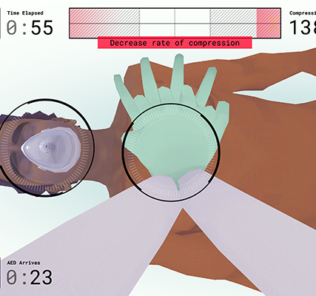SimVS Nucleus for a Realistic Simulated Clinical Environment
SimVS has emerged as a trailblazer in the development of affordable simulated medical device technology, like SimVS Nucleus, to enhance the realism of the experiential learning environment. SimVS Nucleus incorporates four clinical areas into one system for clinical simulation: physiological monitoring, bedside assessment, two-way communication, and medication delivery. This HealthySimulation.com article will explore various aspects of SimVS Nucleus.
SimVS has revolutionized how medical professionals and clinical learners train and practice skills with its groundbreaking line of virtual patient monitors, assessment devices, IV pumps, defibrillators, and more.One of SimVS’s strengths is its ability to work in various clinical simulation environments alongside any other simulation equipment, creating the most realistic learning environment possible. SimVS can be used with various manikins and standardized patients.
View the HealthySimulation.com LEARN CE/CME Platform Webinar Create Immersive Clinical Bed Environments with Tablet-Based Simulated Medical Devices from SimVS to learn more!
Sponsored Content:
Physiological Monitoring
SimVS offers a realistic simulated physiological monitoring. Monitors include the hospital monitor, ventilator monitor, and AED (automatic external defibrillator). These monitors come with scenarios that have customized after-action reviews/checklists with specific details that can be incorporated into the debriefing session. A comprehensive checklist is provided for all pre-programmed scenarios. This allows the faculty member to make notes on the learner’s performance that can be incorporated into the debriefing. These checklists can be edited to allow for customization for faculty-created clinical scenarios. All checklists are shareable through several programs and are automatically graded for a debriefing session.

Instructors can record and view learners’ decision-making in real time through a two-way communication window. The system allows the faculty the ability to send a variety of media to the learner during the clinical simulation. The media can be routine lab values, arterial blood gases, 12-lead EKGs, and questions. This can increase the complexity of the scenario or provide additional information that requires the learner to incorporate the opportunity to multitask or prioritize based on the additional media provided. Faculty can send the learners questions to promote critical decision-making or provide clarity during the simulation.
Sponsored Content:
SimVS Hospital Monitor
The SimVS hospital monitor displays a variety of patient conditions. This allows healthcare providers the opportunity to practice and learn how to multitask, prioritize, pattern recognition, and more. This is accompanied by an extensive preprogrammed scenario library. These scenarios are accompanied with over 200 cardiac and respiratory waveforms.
SimVS AED
In addition to the hospital monitor, the SimVS system has an AED. The defibrillator has 20 ACLS/PALS and 20 nursing med-surg scenarios. The realistic controls come with over 25 events for students to access. Examples of the events are intubation, intraosseous access, medication administration, and response.
SimVS Ventilator Monitor
The ventilator monitor includes 10 ventilator scenarios. The physiology can be easily adjusted by the faculty to reflect changes using sliders and drop-down menus. The modes of ventilation, represented through waveforms, include volume, pressure, AC, SIMV, PSV, CPAP, and APRV. This allows the learners the opportunity to recognize and understand the waveforms. To increase the complexity and realism, ventilator alarms are used to alert the learner to parameters outside the normal range. This requires the learner to recognize and manage the physiological cause of the alarm.
Bedside Assessment

The bedside assessment systems provide monitors for vital signs, pulse oximeter, thermometer, and Point of Care glucometer. A vital signs cart is included. The bedside assessment system can utilize pre-programmed scenarios or full on-the-fly controls.
Two-Way Communication
With SimVS Nurse Call Bell, allows for realistic real-time communication between the hospital room and the nurse station in the clinical simulation environment. The intercom functionality allows for push-to-talk communication between learners and instructors. Additionally, the faculty can send alarm sounds to the tablet which allows students to accept or decline alarms as they would in real-world clinical settings. Learners can also request help at the bedside or call a Code. Two-way communication allows the learner to practice effective communication, prioritization, and leadership skills.
Medication Delivery
SimVS Nucleus has the first and only IV infusion pump simulator to assist learners in the development of safe medication delivery practices. The infusion pump allows learners the opportunity for immersive learning of volume, dose, and weight-based calculations. The learners can navigate drug selection and dosage controls. Faculty can send medication orders to the learners. Another valuable concept is the ability to create intentional errors to measure learner’s response.
More About SimVS
Today, SimVS is one of the world’s most successful providers of simulated medical device monitors, boasting thousands of unit installations on devices across the globe. The founders of SimVS recognized that existing healthcare simulation equipment was both expensive and cumbersome, so an effort was made to create more accessible alternatives that would enhance the clinical training experience. SimVS accomplished this by creating a product line of simulated patient virtual monitors, defibrillators, vital sign devices, call buttons, and ventilators.
Teresa Gore, PhD, DNP, APRN, FNP-BC, CHSE-A, FSSH, FAAN – Dr. Gore has experience in educating future nurses in the undergraduate and graduate nursing programs. Dr. Gore has a PhD in Adult Education, a DNP as a family nurse practitioner, and a certificate in Simulation Education. Dr. Gore is an innovative, compassionate educator and an expert in the field of healthcare simulation. In 2007l Teresa started her journey in healthcare simulation. She is involved in INACSL and SSH. She is a Past-President of INACSL and is a Certified Healthcare Simulation Educator Advanced (CHSE-A). In 2018, she was inducted as a Fellow in the American Academy of Nursing (FAAN). In 2021, she was inducted as a Fellow in the Society of Simulation in Healthcare Academy (FSSH) and selected as a Visionary Leader University of Alabama at Birmingham School of Nursing Alumni. During her career, Dr. Gore has led in the development and integration of simulation into all undergraduate clinical courses and started an OSCE program for APRN students. Her research interests and scholarly work focus on simulation, online course development and faculty development. She has numerous invited presentations nationally and internationally on simulation topics.
Sponsored Content:


















